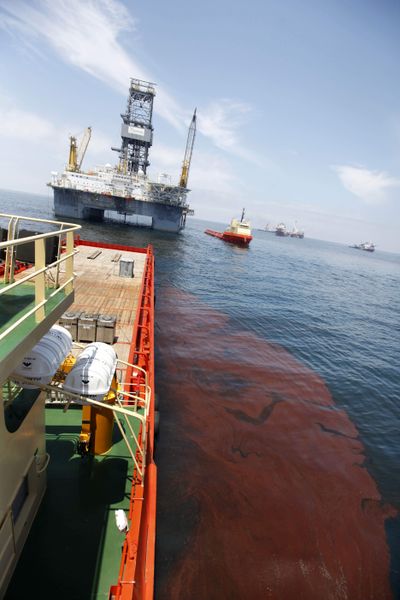Methane bubble triggered oil rig blast
Workers describe chain of events

ON THE GULF OF MEXICO – The deadly blowout of an oil rig in the Gulf of Mexico was triggered by a bubble of methane gas that escaped from the well and shot up the drill column, expanding quickly as it burst through several seals and barriers before exploding, according to interviews with rig workers conducted during BP’s internal investigation.
While the cause of the explosion is still under investigation, the sequence of events described in the interviews provides the most detailed account of the April 20 blast that killed 11 workers and touched off the underwater gusher that has poured more than 3 million gallons of crude into the Gulf.
Portions of the interviews, two written and one taped, were described in detail to an Associated Press reporter by Robert Bea, a University of California at Berkeley engineering professor who serves on a National Academy of Engineering panel on oil pipeline safety and worked for BP PLC as a risk assessment consultant during the 1990s. He received them from industry friends seeking his expert opinion.
A group of BP executives were on board the Deepwater Horizon rig celebrating the project’s safety record, according to the transcripts. Meanwhile, far below, the rig was being converted from an exploration well to a production well.
Based on the interviews, Bea believes that the workers set and then tested a cement seal at the bottom of the well. Then they reduced the pressure in the drill column and attempted to set a second seal below the sea floor. A chemical reaction caused by the setting cement created heat and a gas bubble which destroyed the seal.
Deep beneath the seafloor, methane is in a slushy, crystalline form. Deep-sea oil drillers often encounter pockets of methane crystals as they dig into the earth.
As the bubble rose up the drill column from the high-pressure environs of the deep to the less pressurized shallows, it intensified and grew, breaking through safety barriers, Bea said.
“A small bubble becomes a really big bubble,” Bea said. “So the expanding bubble becomes like a cannon shooting the gas into your face.”
Up on the rig, the first thing workers noticed was the seawater in the drill column suddenly shooting back at them, rocketing 240 feet in the air, he said. Then, gas surfaced. Then oil.
“What we had learned when I worked as a drill rig laborer was swoosh, boom, run,” Bea said. “The swoosh is the gas, boom is the explosion and run is what you better be doing.”
The gas flooded into an adjoining room with exposed ignition sources, he said.
“That’s where the first explosion happened,” said Bea, who worked for Shell Oil in the 1960s during the last big northern Gulf of Mexico oil well blowout. “The mud room was next to the quarters where the party was. Then there was a series of explosions that subsequently ignited the oil that was coming from below.”
According to one transcript, a gas cloud covered the rig, causing giant engines on the drill floor to run too fast and explode. The engines blew off the rig and set “everything on fire,” the account said. Another explosion below blew more equipment overboard.
BP spokesman John Curry would not comment Friday night on whether methane gas or the series of events described in the documents caused the accident.
“Clearly, what happened on the Deepwater Horizon was a tragic accident,” said Curry, who is based at an oil spill command center in Robert, La. “We anticipate all the facts will come out in a full investigation.”
The BP executives were injured but survived, according to one account. Nine rig crew on the rig floor and two engineers died.
“The furniture and walls trapped some and broke some bones but they managed to get in the lifeboats with assistance from others,” said the transcript.
The reports made Bea, the 73-year-old industry veteran, cry.
“It sure as hell is painful,” he said. “Tears of frustration and anger.”
On Friday, a BP-chartered vessel lowered a 100-ton concrete-and-steel vault onto the ruptured well, an important step in a delicate and unprecedented attempt to stop most of the gushing crude fouling the sea.
“We are essentially taking a four-story building and lowering it 5,000 feet and setting it on the head of a pin,” BP spokesman Bill Salvin told the Associated Press.
Underwater robots guided the 40-foot-tall box into place in a slow-moving drama. Now that the contraption is on the seafloor, workers will need at least 12 hours to let it settle and make sure it’s stable before the robots can hook up a pipe and hose that will funnel the oil up to a tanker.
“It appears to be going exactly as we hoped,” Salvin said on Friday afternoon, shortly after the four-story device hit the seafloor. “Still lots of challenges ahead, but this is very good progress.”
By Sunday, the box the size of a house could be capturing up to 85 percent of the oil.